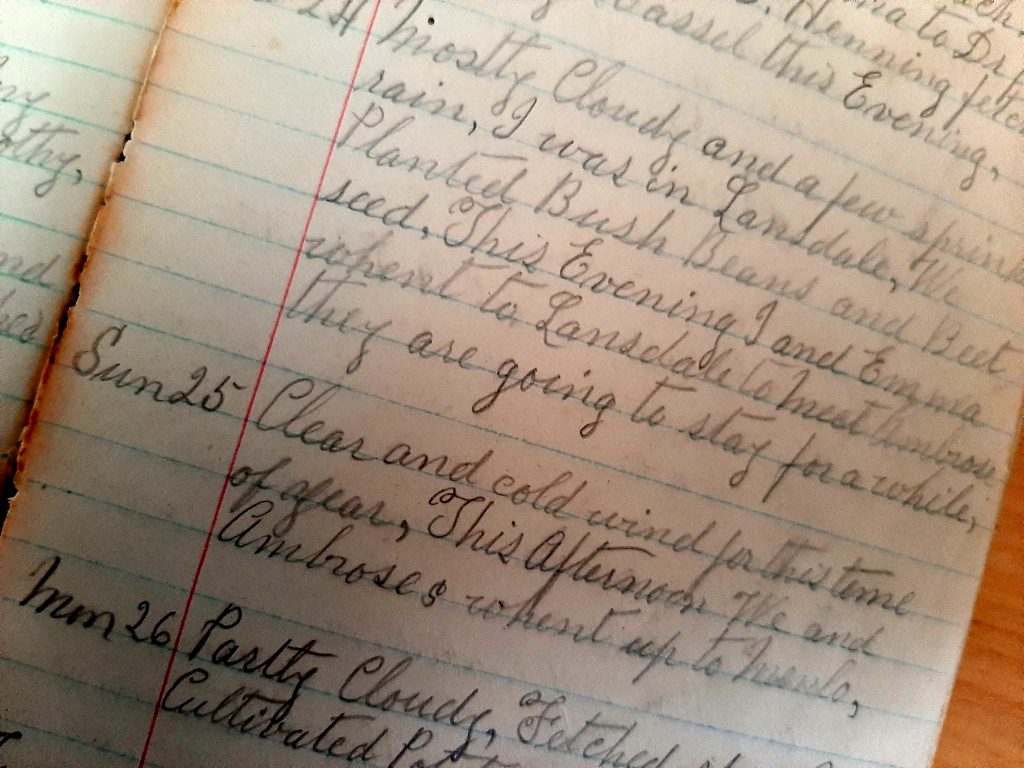For many of us, we often do not think that we will be living history: yet here we are. The spread of COVID-19, our subsequent national social distancing and self quarantining, and the effects of this pandemic on all aspects of our life is only starting to become apparent. Like many, we here at the Morgan Log House have been working from home.
Pandemics and the illnesses they cause have long been part of human history: from the Plague of Justinian of the ancient world, to the Black Death of the fourteenth century, the Yellow Fever epidemics that wracked Philadelphia in the 1790s, Spanish Flu in 1918, and now COVID-19 in 2020.

A major source of information about the past (from times of disease and war to regular times) is from the diaries and writings of the people who lived it. The Morgan Log House’s temporary exhibit this year is centered around the diaries of William Leister, a farmer in Towamencin in the early twentieth century. Leister did not write about the Spanish Flu epidemic, but the local community was certainly impacted by it. Much of what we know about past pandemics is from the writings of regular people, who were recording the events that were happening around them.
This includes the writings of Samuel Pepys, who wrote about the London Pandemic of 1665, which words that seem very relevant today:
“On hearing ill rumour that Londoners may soon be urged into their lodgings by Her Majesty’s men, I looked upon the street to see a gaggle of striplings making fair merry, and no doubt spreading the plague well about. Not a care had these rogues for the health of their elders!”
Pepys did not consider what he was living history: yet there he was.
For us living through COVID-19, a good activity could be to keep a daily journal of the events that are unfolding around us. While the pandemic is today’s news, it will someday be tomorrow’s history. Historians in years from now will be wanting to know what the regular people thought about social isolation and the way the felt as America stayed home to flatten the curve. At the very least, our children and grandchildren (and their children and grandchildren) might find it interesting to know what we did in these strange times. At the very least, keeping a daily journal will add something to do (and to look forward to) every day as we spend time at home. It can also be a good way to sort out the emotions we are all experiencing.
Journals can also be a fun activity for children, both to learn about what is going on, for them to process it, and for an activity to learn about historic journals.
If you do set out to write a journal about your COVID-19 experience, think about the information you can provide for future historians.
It is important to provide context, which should at minimal be a listing of the date (day, month, and year are ideal), You can also include information about where you are, and the people you are with. Additionally, here are some ideas for things you can write about:
- Whatever is going on with the pandemic (including your impressions and how you feel about it)
- Observations you experience: things that might be really applicable here are what it is like to go out to the store, how your life has been impacted, etc.
- How your life has changed, including work, socializing, and ways for spending time.
- Anything you’ve been up to to pass the time: popular activities that people seem to be taking part in are home improvement projects, yard work, board games, and puzzles.
- How the situation is impacting your family members, including your pets
- Anything else you want to write about
We are all living history: now let’s record it!
Stay healthy, friends!
